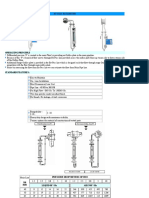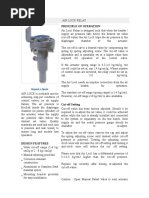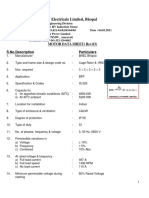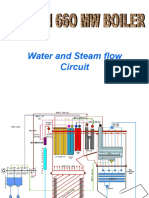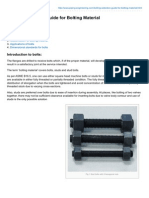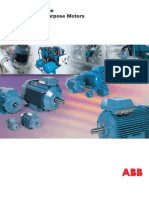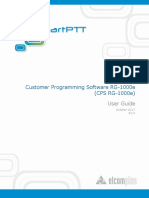PH Sensor Datasheet
PH Sensor Datasheet
Uploaded by
Lussengo AugustoCopyright:
Available Formats
PH Sensor Datasheet
PH Sensor Datasheet
Uploaded by
Lussengo AugustoOriginal Title
Copyright
Available Formats
Share this document
Did you find this document useful?
Is this content inappropriate?
Copyright:
Available Formats
PH Sensor Datasheet
PH Sensor Datasheet
Uploaded by
Lussengo AugustoCopyright:
Available Formats
Tel: 86-15158063876 E-mail: info@supmea.
com
www.supmea.com
pH electrode/ORP electrode
Committed to process automation solutions
Datasheet
SUP-pH
Add : 5th floor, Building 4, Singapore Hangzhou Science
Technology Park, Hangzhou Economic Development Area,
310018, Hangzhou, China
Tel: 86-15158063876 E-mail: info@supmea.com
www.supmea.com
Supmea pH electrode is a high-quality sensor for the analysis and measurement of liquid components
during industrial automation. These electrodes are known for their use of top-quality materials and
components. They are designed as combined electrodes (the measuring electrode and the reference
electrode are combined in one shaft).The temperature probe can also be integrated as an option.
According to different environments to provide electrodes to meet the requirements
■ For industrial sewage engineering measurements
■ For high-alkaline liquid measurements
■ For high acidic liquid measurements
■ For high-temperature sterilization processes measurements
■ For desulfurization process liquid analysis
■ For measurements in low-ion media
Signal parameters
Electrode slope: The slope of the glass electrode is 59.16 mV at 25 ℃ theoretically, i.e. potential change of
59.16 mV for each pH change in the solution. But in fact, neither glass electrode can reach the theoretical
value 100%; in general, the electrode slope is more than 98% of the theoretical value (percentage slope).
In addition, the mV difference corresponding to each unit pH value varies under different temperatures. The
conversion of temperature to electric potential difference is as follows:
△E=59.16*[(273+T)/298]*△pH
Add : 5th floor, Building 4, Singapore Hangzhou Science
Technology Park, Hangzhou Economic Development Area,
310018, Hangzhou, China
Tel: 86-15158063876 E-mail: info@supmea.com
www.supmea.com
Type of pH electrode
Electrode model Designation pH and ORP range Temperature range
SUP-pH5011 Plastic pH electrode 0-14pH 0-60℃
SUP-pH5013A PTFE pH electrode 0-14pH 0-60℃
SUP-pH5014 Glass pH electrode 0-14pH 0-130℃
High Temperature Glass
SUP-pH5015 0-14pH 0-130℃
pH electrode
SUP-pH5016 Plastic pH electrode 0-14pH 0-80/>100℃
SUP-pH5017 Glass pH electrode 0-14pH 0-130℃
SUP-pH5018 Glass pH electrode 0-14pH 0-100℃
SUP-pH5019 Plastic pH electrode 0-14pH 0-60℃
SUP-pH5041 Glass pH electrode 0-14pH 0-90℃
SUP-pH5100 Glass ORP electrode 0-14pH 0-130℃
Features of pH electrode
■ Adopt international advanced solid dielectric and large area PTFE liquid junction, easy maintenance.
■ Long distance reference diffusion path, extends electrode life greatly in harsh environments.
■ Electrode is made of high quality low-noise cable, make signal output length greater than
40 meters or more, without interference.
■ High accuracy, fast response, good repeat-ability.
■ With silver ions Ag / Ag-Cl reference electrode.
■ Side or vertically installation to the reaction tank or pipe.
■ Electrode can be used interchangeably with similar electrodes.
Add : 5th floor, Building 4, Singapore Hangzhou Science
Technology Park, Hangzhou Economic Development Area,
310018, Hangzhou, China
Tel: 86-15158063876 E-mail: info@supmea.com
www.supmea.com
Electrode parameters
SUP-pH5014 SUP-pH5015
■ Technical parameters ■ Technical parameters
Measure range: 0-14pH Measure range: 0-14pH
Temperature range: 0-130℃ Temperature range: 0-130℃
Temperature compensation: Pt100/Pt1000/NTC10K Temperature compensation: Pt100/Pt1000/NTC10K
Pressure resistant: 0 ~ 6 Bar at 0 ~ 100℃; ≥ 10 Bar at 25 ℃ Connector: VP, S8M, K2, etc.
Electrode interface: S8, VP, K2, etc. Zero potential point: 7 ±0.5 pH
Zero potential point: 7 ± 0.5 pH Conversion coefficient: > 98%
Conversion coefficient: > 98% Membrane resistance: general: <250ΜΩ
Membrane resistance: <50, 250ΜΩ Practical response time: < 1 min
Practical response time: < 1 min Salt bridge: Porous ceramic core; porous Teflon
Salt bridge: OPEN salt bridge without liquid junction Pressure resistance: up to 6 Bar at 25 ℃
Thread Connection: PG13.5 Thread Connection: PG13.5
■ Application ■ Application
In the dilution control of hydrofluoric acid in semiconductor In various chemical processes including microbial
wafer fabrication and chip production; determination of pH technology, pharmaceuticals, food and beverages,
value in petrochemical industry, iron and steel production sugar manufacturing, chlor-alkali, mining and smelting,
wastewater and other strong corrosive systems. paper pulp, textiles, petrochemical industry and
semiconductor electronic industry as well asfields such as
wastewater treatment.
Add : 5th floor, Building 4, Singapore Hangzhou Science
Technology Park, Hangzhou Economic Development Area,
310018, Hangzhou, China
Tel: 86-15158063876 E-mail: info@supmea.com
www.supmea.com
SUP-pH5016 SUP-pH5017
■ Technical parameters ■ Technical parameters
Measure range: 0-14pH Measure range: 0-14pH
Temperature range: 0--80℃ for general cables Temperature range: 0-130℃
>100℃for high temperature cable Temperature compensation: Pt100/Pt1000/NTC10K
(or cable not immersed in solution) Connector: VP, S8M, K2, etc.
Temperature compensation: Pt100/Pt1000/NTC10K Zero potential point: 7 ± 0.25 pH
Zero potential point: 7 ± 0.5 pH Conversion coefficient: > 98%
Conversion coefficient: > 98% Membrane resistance: <600ΜΩ
Membrane resistance: <250ΜΩ Practical response time: < 1 min
Practical response time: < 1 min Pressure resistance: up to 6 Bar at 25 ℃
Salt bridge: salt bridge porous Teflon Thread Connection: PG13.5
Pressure resistance: 1 ~ 6 Bar at 25 ℃
Thread Connection: 3/4NPT
■ Application ■ Application
In wastewater treatment and in the fields including In various chemical processes including chlor-alkali,
mining and smelting, papermaking, paper pulp, mining and smelting, papermaking, paper pulp, textiles,
textiles, petrochemical industry, process of petrochemical industry and semiconductor electronic
semiconductor electronic industry, and downstream industry as well as fields such as biotechnology and
engineering of biotechnology. wastewater treatment.
Add : 5th floor, Building 4, Singapore Hangzhou Science
Technology Park, Hangzhou Economic Development Area,
310018, Hangzhou, China
Tel: 86-15158063876 E-mail: info@supmea.com
www.supmea.com
SUP-pH5018 SUP-pH5019
■ Technical parameters ■ Technical parameters
Measure range: 0-14pH Measure range: 0-14pH
Temperature range: 0-100℃ Temperature range: 0--60℃ for general cables
Temperature compensation: Pt100/Pt1000/NTC10K Temperature compensation: 10
Connector: VP, S8M, K2, etc. KΩ/2.252KΩ/Pt100/Pt1000
Zero potential point: 7 ± 0.5 pH Zero potential point: 7 ± 0.5 pH
Conversion coefficient: > 98% Conversion coefficient: > 98%
Membrane resistance: general: <250ΜΩ Membrane resistance: <250ΜΩ
Practical response time: < 1 min Practical response time: < 1 min
Salt bridge: Porous ceramic core/ porous Teflon Salt bridge: Porous Teflon
Pressure resistance: up to 4 Bar at 25 ℃ Pressure resistance: 1 ~ 3 Bar at 25 ℃
Thread Connection: PG13.5 Thread Connection: 3/4NPT
■ Application ■ Application
In various chemical processes including microbial In sewage treatment and fields including mining and
technology, pharmaceuticals, food and beverages, smelting, papermaking, paper pulp, textiles,
sugar manufacturing, chlor-alkali, mining and petrochemical industry, process of semiconductor
smelting, papermaking, paper pulp, textiles, electronic industry and downstream engineering
petrochemical industry and semiconductor electronic of biotechnology.
industry as well as fields such as sewage treatment.
Add : 5th floor, Building 4, Singapore Hangzhou Science
Technology Park, Hangzhou Economic Development Area,
310018, Hangzhou, China
Tel: 86-15158063876 E-mail: info@supmea.com
www.supmea.com
SUP-pH5100 SUP-pH5011
■ Technical parameters ■ Technical parameters
Measure range: 0-14pH Measure range: 0--14 pH
Temperature range: 0-130℃ Temperature range: 0-60℃
Temperature compensation: Pt100/Pt1000/NTC10K Temperature compensation: Pt100/Pt1000/NTC10K
Connector: K2, VP, etc. Zero potential point: 7±0.25
Zero potential point: 7 ±0.25 pH Conversion coefficient:≥95%
Conversion coefficient: > 98% Membrane resistance: <500Ω
Membrane resistance: <250ΜΩ Practical response time:< 1 min
Practical response time: < 1 min Reference: Ag/AgCl
Salt bridge: special porous ceramic core Pressure resistance: 4 bar at 25 ℃
Pressure resistance: up to 1 Bar at 25 ℃ Thread Connection: 3/4NPT
Thread Connection: PG13.5 Material: PPS/PC
■ Application ■ Application
In pure water and high purity water as well as complex Suitable for general industrial waste water
chemical processes. and discharge solutions
Add : 5th floor, Building 4, Singapore Hangzhou Science
Technology Park, Hangzhou Economic Development Area,
310018, Hangzhou, China
Tel: 86-15158063876 E-mail: info@supmea.com
www.supmea.com
SUP-pH5041 SUP-pH5013A
■ Technical parameters ■ Technical parameters
Measure range: 0--14 pH Measure range: 0-14pH
Temperature range: 0~90℃ Temperature range: 0--60℃
Temperature compensation: Pt100/Pt1000/NTC10K Temperature compensation: Pt100/Pt1000/NTC10K
Zero potential point: 7±0.25 Zero potential point: 7±0.25
Conversion coefficient: ≥95% Conversion coefficient: ≥95%
Membrane resistance: <500Ω Membrane resistance: <500Ω
Practical response time: < 1 min Practical response time: < 1 min
Reference: Ag/AgCl Reference: Ag/AgCl
Pressure resistance: 1 bar at 25 ℃ Pressure resistance: 4 bar at 25 ℃
Thread Connection: PG13.5 Thread Connection: 3/4NPT
Material: PTFE
■ Application ■ Application
Suitable for pH measurement of industrial field solutions Low-impedance glass sensitive film, wear-resistant, strong
with relatively poor working conditions and corrosive acid and alkali resistant, with protection ring in the the front
plastics. to protect glass bulb and better precision and linearity.
Related product
Add : 5th floor, Building 4, Singapore Hangzhou Science
Technology Park, Hangzhou Economic Development Area,
310018, Hangzhou, China
Tel: 86-15158063876 E-mail: info@supmea.com
www.supmea.com
PTFE pH sheath Stainless steel pH sheath
Flow cup Electronic controlled box
Installation of electrode
Add : 5th floor, Building 4, Singapore Hangzhou Science
Technology Park, Hangzhou Economic Development Area,
310018, Hangzhou, China
Tel: 86-15158063876 E-mail: info@supmea.com
www.supmea.com
Schematic diagram of common installation method
① Side wall installation
② Flange mounted at the top
③ Pipe installation
④ Top installation
⑤ Submersible installation
⑥ Flow-through installation
The interface must be in 15°oblique angle, or it will affect the normal test and use of the electrode. We wo
n’t be responsible for any results due to this.
pH Calibration
Add : 5th floor, Building 4, Singapore Hangzhou Science
Technology Park, Hangzhou Economic Development Area,
310018, Hangzhou, China
Tel: 86-15158063876 E-mail: info@supmea.com
www.supmea.com
A pH calibration is the procedure of adjusting the pH meter by measuring solutions of known pH values.
The characteristic of a pH electrode will change with time due to electrode coating and aging. And even a
pH electrode would be stable over time, pH electrodes cannot be produced with identical characteristics.
In practice the response of a real pH sensor does not exactly follow the Nernst equation. This difference
between the theoretical and actual behavior of a pH electrode must be compensated for. A calibration is
required to match the pH meter to the current characteristics of the used pH sensor.
To achieve the best possible accuracy, the calibration should cover the range of the desired measurement
values. If the readings go beyond the calibrated range, the pH meter assumes linearity and simply
extrapolates the value to be displayed. The true value may be slightly different.
More advanced pH meters will let the user calibrate at three, four or five and even higher numbers of pH
values. A multi-point calibration mean, in comparison to a two-point calibration, that you can calibrate your
pH tester on both sides of the zero point (pH 7.00). This will expand your pH measurement range without
the need of recalibrating.
Add : 5th floor, Building 4, Singapore Hangzhou Science
Technology Park, Hangzhou Economic Development Area,
310018, Hangzhou, China
You might also like
- Making Industrial SystemsDocument5 pagesMaking Industrial SystemsAmit ShaliNo ratings yet
- Mechanical Er. A. Suresh ResumeDocument4 pagesMechanical Er. A. Suresh ResumeGovindarajan ChandraNo ratings yet
- Schumann Frequency Oscillator With Scalar CoilDocument1 pageSchumann Frequency Oscillator With Scalar CoilakordysNo ratings yet
- McQuay MCC Data Sheet EngDocument1 pageMcQuay MCC Data Sheet EngSaeful Malik GintingNo ratings yet
- N1P 1.5 P1T2 BLK LDocument2 pagesN1P 1.5 P1T2 BLK LRijo RajanNo ratings yet
- Blast Furnace Gas-Fired Boiler For Eregli Iron & Steel Works (Erdemir), TurkeyDocument6 pagesBlast Furnace Gas-Fired Boiler For Eregli Iron & Steel Works (Erdemir), TurkeyRaj KumarNo ratings yet
- Excitation Systems: Raman JainDocument15 pagesExcitation Systems: Raman JainrohitctppNo ratings yet
- By Pass RotameterDocument6 pagesBy Pass Rotameterkrishna kumarNo ratings yet
- DH3 BuckstayDocument1 pageDH3 BuckstayariyaNo ratings yet
- 15-Produced Water Injection CoolerDocument1 page15-Produced Water Injection CoolerLe vuNo ratings yet
- My Latest CV - EngineerDocument3 pagesMy Latest CV - EngineersasibhushanNo ratings yet
- IVGE Butterfly ValveDocument2 pagesIVGE Butterfly ValvejprakashbandaruNo ratings yet
- RooftopDocument4 pagesRooftophjduarteNo ratings yet
- Measurement PressureDocument20 pagesMeasurement Pressurelp mishraNo ratings yet
- Kuliah 7 - Fuzzy Inference SystemDocument29 pagesKuliah 7 - Fuzzy Inference Systemtutur ramdaniNo ratings yet
- Process GCs/Process Analyzers (Total VOCs)Document4 pagesProcess GCs/Process Analyzers (Total VOCs)Jennifer MaclachlanNo ratings yet
- Gross Turbine Cycle Heat Rate Ch-8.2Document12 pagesGross Turbine Cycle Heat Rate Ch-8.2levelhead28No ratings yet
- Control Valves Data Sheet: Client: PlantDocument1 pageControl Valves Data Sheet: Client: PlantAnoNo ratings yet
- Purpose: Scope: Responsibility: Guide Line:-: Line Up Procedure For Normalization of CW PumpsDocument4 pagesPurpose: Scope: Responsibility: Guide Line:-: Line Up Procedure For Normalization of CW PumpsSubhasish mukherjeeNo ratings yet
- Sequencially Interlocking-CepDocument4 pagesSequencially Interlocking-Cepanbesivam87_49857255No ratings yet
- C&i SystemsDocument116 pagesC&i SystemsbamzNo ratings yet
- Globe ValvesDocument7 pagesGlobe ValvesAngela IlaganNo ratings yet
- Flash Tank Heat Recovery Operating and Maintenance ManualDocument2 pagesFlash Tank Heat Recovery Operating and Maintenance ManualCastoriadisNo ratings yet
- Selecting An HVAC Pump at HttpsDocument3 pagesSelecting An HVAC Pump at Httpsalone160162lNo ratings yet
- Air Lock RelayDocument2 pagesAir Lock RelaynithyaNo ratings yet
- BOP Operating Manual 2011-12Document45 pagesBOP Operating Manual 2011-12Jagdeep ArryNo ratings yet
- Role of Instrumentation in Thermal Power Plant: Tejal K. Gote Batch: N62 NTC EklahareDocument23 pagesRole of Instrumentation in Thermal Power Plant: Tejal K. Gote Batch: N62 NTC EklahareAvishkar GoteNo ratings yet
- Vol III Rate Schedule For Chimney-BhelDocument18 pagesVol III Rate Schedule For Chimney-BhelMallinatha PNNo ratings yet
- 1 3 Vacuum MeasurementDocument8 pages1 3 Vacuum Measurementmanikandaprabhu100% (1)
- Info Eddy CurrentDocument8 pagesInfo Eddy CurrentFederico Palma YobeNo ratings yet
- Instrumentation Scheme of Thermal Power PlantDocument39 pagesInstrumentation Scheme of Thermal Power Plantgdreddy25No ratings yet
- Tech Spec of Cpu - EnnoreDocument683 pagesTech Spec of Cpu - Ennoretanumay.geminiNo ratings yet
- Rei Vol ViDocument111 pagesRei Vol ViDineshNo ratings yet
- 05 - C&iDocument120 pages05 - C&iBhargav ChaudhariNo ratings yet
- Hydraulic TestDocument3 pagesHydraulic TestSaurabh BarangeNo ratings yet
- Technical Data & Curves For BFP Motor (MDL#BPL-027) - R3 - Cat A Approved DTD 16.03.2011Document12 pagesTechnical Data & Curves For BFP Motor (MDL#BPL-027) - R3 - Cat A Approved DTD 16.03.2011Bijaya Kumar MohantyNo ratings yet
- KG - 008 Write Up For Steam Blowing Scheme For Khargone Units PDFDocument92 pagesKG - 008 Write Up For Steam Blowing Scheme For Khargone Units PDFHimanshu ChaturvediNo ratings yet
- 11V02 Acc SPC M 0001 V2 Part DDocument58 pages11V02 Acc SPC M 0001 V2 Part DsuparnabhoseNo ratings yet
- Switchyard Fence Drawing DetailsDocument2 pagesSwitchyard Fence Drawing DetailsSagun KatuwalNo ratings yet
- Centrifugal Pump: Net Positive Suction Head (NPSH)Document4 pagesCentrifugal Pump: Net Positive Suction Head (NPSH)Sohibul Burhan Ar-RosyidNo ratings yet
- Rei Vol IiDocument142 pagesRei Vol IiDineshNo ratings yet
- Presentation of PressureDocument44 pagesPresentation of PressureMuskan GargNo ratings yet
- Cleaning BallsDocument11 pagesCleaning BallsG.SWAMINo ratings yet
- Esp PPT NabinagarDocument16 pagesEsp PPT NabinagarKhemant OdNo ratings yet
- ECF-SSF Actuator Catalogue DTD 08 11Document20 pagesECF-SSF Actuator Catalogue DTD 08 11manmohansingh1999No ratings yet
- Sample Coolers, Sample Cooler, Manufacturer, Supplier, Pune, IndiaDocument3 pagesSample Coolers, Sample Cooler, Manufacturer, Supplier, Pune, IndiaBehzad Totakhaneh BonabNo ratings yet
- Cooling Water System Control Philosophy (25Mw) : ObjectiveDocument8 pagesCooling Water System Control Philosophy (25Mw) : ObjectiveEric Taylor100% (1)
- Pvunl: Pre-Feasibility Report For Patratu Super Thermal Power Project Phase-1 (3x800 MW)Document18 pagesPvunl: Pre-Feasibility Report For Patratu Super Thermal Power Project Phase-1 (3x800 MW)blazeglory100% (1)
- Pressure Control Valve Self Actuated: GeneralDocument1 pagePressure Control Valve Self Actuated: GeneralJorge RodríguezNo ratings yet
- Boiler ManualDocument424 pagesBoiler ManualDivisional Engineer KTPS-VINo ratings yet
- 660mw Boiler Steam and Water Flow CircuitDocument2 pages660mw Boiler Steam and Water Flow CircuitSenthil KumarNo ratings yet
- Dec 09Document35 pagesDec 09Krishnan SanthanarajNo ratings yet
- TurbidityDocument1 pageTurbidityAmir ShahzadNo ratings yet
- Ibd TankDocument2 pagesIbd Tankjasmeet_5563No ratings yet
- Relief ValveDocument2 pagesRelief ValveAdil AzizNo ratings yet
- Specification For Hot Water BoilersDocument1 pageSpecification For Hot Water BoilersKarthik AnandanNo ratings yet
- Bolting Selection Guide For Bolting MaterialDocument5 pagesBolting Selection Guide For Bolting Materialthuyenquyen_vtNo ratings yet
- Rotameter SizingDocument1 pageRotameter SizingDave ToExtreme100% (1)
- Colour Codes For Tubes & Pipes (BHEL)Document1 pageColour Codes For Tubes & Pipes (BHEL)Joydev GangulyNo ratings yet
- PH Meter Data SheetDocument10 pagesPH Meter Data SheetSomiar TradingNo ratings yet
- Steam and Water Analysis System (Swas) : Submitted byDocument101 pagesSteam and Water Analysis System (Swas) : Submitted bySrinivasarao YenigallaNo ratings yet
- 27, 28 Cảm biến ORP 08351=C=0000, Cảm biến PH 08350=C=0004Document4 pages27, 28 Cảm biến ORP 08351=C=0000, Cảm biến PH 08350=C=0004Việt Hùng NghiêmNo ratings yet
- General Purpose Motors - EN - 12 - 2006 PDFDocument236 pagesGeneral Purpose Motors - EN - 12 - 2006 PDFpablopasqualini18No ratings yet
- Literature Review of Automatic Plant Irrigation SystemDocument6 pagesLiterature Review of Automatic Plant Irrigation Systemc5rjgvg7No ratings yet
- Microwave Oven: Service ManualDocument36 pagesMicrowave Oven: Service ManualAnonymous 2iQ1B59No ratings yet
- Fun With MagnetsDocument2 pagesFun With MagnetsRosy KaushikNo ratings yet
- RRU3938 Description: Huawei Technologies Co., LTDDocument14 pagesRRU3938 Description: Huawei Technologies Co., LTDOperation ColomboNo ratings yet
- NFPA 25, Chapter 8Document7 pagesNFPA 25, Chapter 8Sahara SneedanNo ratings yet
- ESO Transparency Forum 23-08-09Document27 pagesESO Transparency Forum 23-08-09Madhusudhan SrinivasanNo ratings yet
- Improvement To Increase CRT Reliability (C - P0310)Document2 pagesImprovement To Increase CRT Reliability (C - P0310)CefoNo ratings yet
- Implementation of GSM Based Heart Rate and Temperature Monitoring SystemDocument7 pagesImplementation of GSM Based Heart Rate and Temperature Monitoring SystemPriyanka BujugundlaNo ratings yet
- Daikin AC Quote, Ageo TechnologiesDocument3 pagesDaikin AC Quote, Ageo TechnologiesAnuradha AcharyaNo ratings yet
- CPS RG-1000e User Guide R2.0Document50 pagesCPS RG-1000e User Guide R2.0SmartPTTNo ratings yet
- Cer Final AssessmentDocument3 pagesCer Final AssessmentT. Danielle DockeryNo ratings yet
- PVS980 Product and O - M TrainingDocument34 pagesPVS980 Product and O - M Trainingthuydiendakre2No ratings yet
- Fdocuments - in - Assessment For Sparc t5 Installation and MaintenanceDocument9 pagesFdocuments - in - Assessment For Sparc t5 Installation and MaintenancejoelNo ratings yet
- UCG120-12 Physical Specification: SpecificationsDocument2 pagesUCG120-12 Physical Specification: SpecificationsPablo SchinkeNo ratings yet
- Fundamentals of HVDC and FACTS Devices QBDocument24 pagesFundamentals of HVDC and FACTS Devices QBdeptai2023No ratings yet
- Smart Energy Solutions To Smart Grid ChallengesDocument191 pagesSmart Energy Solutions To Smart Grid Challengesenergi utNo ratings yet
- 8-Bit Shift Register With 8-Bit Output RegisterDocument11 pages8-Bit Shift Register With 8-Bit Output RegisterWILLIAM AGUDELONo ratings yet
- Dspic 30Document248 pagesDspic 30ariel_cacciaNo ratings yet
- Molex Ethernet Cable PDFDocument1 pageMolex Ethernet Cable PDFK Vinoth ShivanNo ratings yet
- Circuit Diagrams: MAIN PWB CIRCUIT DIAGRAM (AV-29B316/B) (1/4) (2/4) SHEET1Document4 pagesCircuit Diagrams: MAIN PWB CIRCUIT DIAGRAM (AV-29B316/B) (1/4) (2/4) SHEET1Fede DiNo ratings yet
- Ac GeneratorsDocument46 pagesAc GeneratorsShairra Niña Chiu RodriguezNo ratings yet
- A Broadband Low Noise Amplifier Mmic in 0.15M Gaas Phemt TechnologyDocument3 pagesA Broadband Low Noise Amplifier Mmic in 0.15M Gaas Phemt TechnologyNouha Al-MajedNo ratings yet
- AC Electrical Circuit Analysis - A Practical Approach (Fiore)Document300 pagesAC Electrical Circuit Analysis - A Practical Approach (Fiore)Akun Aya Org, Kepanitiaan, dsbNo ratings yet
- SUMAN Internship Project ReportDocument10 pagesSUMAN Internship Project ReportShahilsingh SinghNo ratings yet
- DSP Final Exam FS 2022Document1 pageDSP Final Exam FS 2022Mohmmed AbdallhNo ratings yet
- Asus Sabertooth z97 Mark 2 Repair GuideDocument6 pagesAsus Sabertooth z97 Mark 2 Repair GuideJavier MendezNo ratings yet
- KicadDocument87 pagesKicadKiss IstvánNo ratings yet







